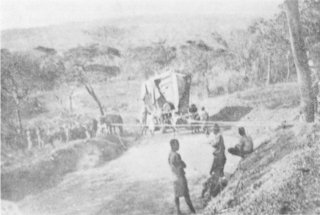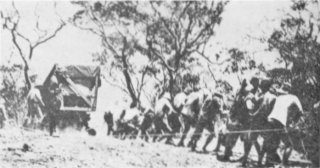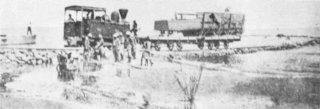

 The South African
The South African
From earliest times the ships of various nations have sailed the seven seas. So, too, at various times, the navies of different nations have sailed the great inland lakes, some perforce having to haul their gunboats over vast stretches of inhospitable land under the most difficult and trying circumstances, including tractless veld, dense bush and harassment by hostile local inhabitants. Due to the necessary veil of secrecy which prevailed at the time some have never been fully recorded. The feat related in this article is perhaps the most ambitious and longest of them all, and for sheer optimism it has surely never been surpassed.
For many years prior to the outbreak of the 1914-18 War the German Navy operated a gunboat Kingani as well as three or four other armed vessels in the very heart of Africa, on Lake Tanganyika. Control of the lake by the Germans proved a big thorn in the side of the forces who opposed General Von Lettow-Vorbeck during the German East Africa Campaign, since the ships assisted greatly in the transportation of much needed supplies.
The threat had been evident from the very beginning, and the seemingly insurmountable problem constantly exercised the minds of many of those at Admiralty House. It soon became imperative that a solution be found, the obvious one being to send ships overland to do battle with the already firmly entrenched German Navy; a solution which appeared totally impracticable.
As has so often been the case in warfare necessity is the mother of invention, and even when invention fails the seemingly impossible has been achieved by those with imagination and determination. The Admiralty decided that the impossible was worth an attempt, and once the decision had been taken every foreseeable detail was methodically tackled and worked out by a few who were "in the know". Secrecy was of paramount importance and all possible steps were implemented to achieve this. It was realized that the only possible hope lay in the vital element of surprise.
After much burning of midnight oil and hard work two motor launches, named Mimi and Toutou, and twenty-eight men left Tilbury early in 1915 on their long journey. A small advance-guard had already gone ahead to make a survey of the route which lay through the Congo, and to commence the work of felling and removing thousands of trees -- literally cutting a passage through the thick jungle. This was accomplished with the aid of the Belgian authorities who supplied the necessary labour.

Lieutenant-Commander A. Spicer-Simson had been selected to command the expedition. His ships, which had been specially built for the purpose, were each of four and a half tons, forty feet in length and designed for a speed of 15 knots. Each had been fitted with one 3-pounder gun, with the usual supply of small arms.
At Cape Town the motor launches were carefully hoisted out of the steamer, loaded on railway trucks and methodically secured. The small fleet left Cape Town on the commencement of the long overland portion of the journey on the 19 July -- the immediate objective being rail-head some 2,300 miles further North.
Elizabethville was eventually reached without untoward incident and, having been joined by the advance guard, the entire party pulled out for the rail-head at Fungurume. Here a camp was established and the little ships carefully removed from the trucks. Here, too, much rethinking and planning were necessary as the problems encountered were formidable. Local experts were most pessimistic, openly stating that success was impossible.
Conditions were much worse than had been apparent from the charts and maps studied with such meticulous care in England. The bush appeared much more dense; the gradients steeper and the terrain in general more difficult. The immediate task was to get the Navy to Sankisia, 150 miles distant, without mishap. The route lay over a mountain range 6,000 feet above sea level and through unknown bush, probably as thick as anywhere in Africa.

However, all the ingredients for success, mainly a knowledge of forestry, traction engines and transport, and general individual fitness of the small party, had all been catered for. The party was far too small to permit of casualties and Dr. H. McG. Hanschell, from the London School of Tropical Medicine, had been appointed to take charge of the medical arrangements. He had taken every conceivable precaution to ensure and to maintain the health of the men placed in his care.
It was not until the middle of August that all was ready to attempt the long haul. Two traction engines were to tow the Mimi and Toutou, which had by this time been loaded onto carriages with large wheels. Each had been secured in a specially constructed cradle. As auxiliary power a number of trek oxen accompanied the party, the plan being to make the lake in three 50-mile stages, with a depot between each.
Slowly but purposefully the convoy moved towards its goal, meeting and overcoming every conceivable difficulty. Broken tow ropes, engine trouble, the inevitable abundance of dongas and sluits which had to be filled in with felled tree trunks, tropical storms and terrific heat; all these and more restricted progress at times to no more than a mile a day. Came times when even the combined power of the modern and the ancient failed, and Lt.-Cmdr. Simson had to resort to a system of pulley-block haulage.
Fighting against time with the all too familiar trait of Africa, either too much or too little water, the highest point of the journey was eventually reached at the end of September. The descent, in many ways equally as difficult as the ascent, was commenced almost immediately, spurred on by the onset of rain which heralded the fast approaching seasonal torrential downpours.
At long last, after much adventure but without mishap to the all-important ships, the convoy arrived at Sankisia. Being another rail-head the ships were once more laboriously transferred to railway trucks and moved another fifteen miles to Bukama on the banks of the Lualaba River.
More or less in their own element many difficulties still lay ahead. Even for such small craft the water was mostly too shallow and progress was frequently checked by sandbanks. With the aid of protective casks lashed to the bottom of the little ships plus, in places, having to be towed by a flat-bottomed steamer, a further four hundred miles slipped by.
Towards the end of October Kabalo, yet another railhead, was reached and the now familiar process of reloading the fleet for the final five miles of the journey to Tanganyika was undertaken with much relief if not gusto. Over the last couple of miles a line had to be laid, and finally a small breakwater of boulders built, to permit of the ships being successfully launched. A small harbour called Katemie, not far from Albertville where the Belgians maintained a small garrison, had been chosen for this purpose.

While these final time-consuming chores were being completed, the ships were kept hidden in the nearby bush as a precaution against being sighted by the German Navy. For once nature appears to have favoured the party and good progress was made in the construction of the breakwater - Africa can usually be relied upon to provide a reasonable quota of rock at any given place.
Good planning, coupled with a sprinkling of luck, enabled the little fleet to be successfully launched on Christmas eve.
Christmas day was celebrated by the crews of the little ships with a well-earned holiday, coupled with what little gaiety as was possible. Although preparations were made with all haste, immediate action was far from the minds of Lt.-Cmdr. Simson and the crews of the four and a half ton gunboats H.M.S. Mimi and Toutou. It was anticipated that the little fleet, having achieved the valuable element of surprise, would seek out the enemy in its own time.
Expectations were very rudely shattered when, at 0840 hours on Boxing Day, the 53-ton enemy monster Kingani was sighted. Neither her captain nor crew had observed the British boats as she steamed serenely past. Only when some distance away did Simson give the order to take up pursuit -- the British ships held only a single advantage, that of greater speed.
It was some two hours later that the distance between the Kingani was sufficiently closed so as to enable H.M.S. Mimito open the attack with lyddite shells. As the range was rapidly reduced to less than 2,000 yards, rifles and quick-firing guns of first the one, followed immediately by the other of the pursuing ships, were brought into action with telling effect.
The captain of the enemy ship was completely taken by surprise and was given no opportunity to recover and offer any real resistance. His 12-pounder gun could not fire astern and was crippled at a very early stage of the action. The accurate shell-fire started a number of fires on board and inflicted a number of casualties, including the captain who was killed. In order to escape the deadly fire some of the crew took to the water.
In less than a quarter of an hour the engineer, who had taken over command of the ship, surrendered. All that remained to be done was to bring the stricken ship as near the harbour as possible, where she was beached in a sinking condition.
Repairs were soon effected to the Kingani, and before long she was put into commission as H.M.S. Fifi - a very valuable asset indeed since, within a matter of weeks, Simson had lost the Toutou which sank in a heavy storm. Anyone who has not been on the lake cannot believe the ferocity of the mountainous waves which a tropical storm is capable of whipping up.
Early during the morning of February 9th, 1916, the second and most exciting action for supremacy of the lake took place. This time it was against the second largest of the German fleet Hedwig von Wissmann - a formidable ship of some 150 tons and 70 feet in length. On sighting the German the Fifi and Mimi immediately took up the chase.
With the faster speed Mimi forged ahead and opened the attack, taking good care to remain beyond range of the only gun mounted in the stern. Her accurate shelling compelled the German ship to take evasive action by zigzagging. This in turn enabled the Fifi to close the distance and to bring her 12-pounder into action.
This spirited action developed into a running fight, with the German suffering many hits but refusing to surrender. Some three hours after the action had been joined the Mimi crept up to within 4,000 yards and, assisted by the Fifi still some distance in the rear, rained shot after shot with accurate precision, into the German. Before long the engine room suffered fairly extensive damage and numerous fires had been started and were beyond control. Still the enemy refused to surrender and fought back stoutly and gallantly until their ship sank under them, with her colours still flying defiantly. Twenty of the crew were rescued and taken prisoner.
Half the German Navy had now been accounted for, but one of the ships with which battle still remained to be joined was the Graf von Gotzen, a monster of 850 tons with an armament which excelled either of those already denied the enemy. However, it was the other remaining vessel, a small but fast motor-boat, which was the next to fall foul of the little fleet. When sighted one day her commander promptly ran her aground and set her afire.
The action of the captain of the Graf von Gotzen was even more ignoble. He decided to scuttle his ship rather than face the little Mimi and the Fifi. To prevent her falling into the hands of the British he had her filled with cement before opening the seacocks and sending her to the bottom of the lake without even a single shot being fired.
Not even the most optimistic -- and in the long history of the Royal Navy there has been many an optimist - could have foreseen such a spectacular conclusion to a venture which at most, from the very onset, presented such little hope of ultimate complete success. By achieving the virtual impossible Simson had made for himself a niche in the history of the Royal Navy. In the space of a few months Lake Tanganyika had been cleared of the enemy and the Royal Navy had made a telling contribution in the very heart of Africa and far removed from her traditional habitat.
Despite this most grave set-back the German Commander Von Lettow-Vorbeck - the Fox of Africa - was able to hold out until the end of hostilities. Who knows what might have been had the German Navy overwhelmed the two puny ships which had travelled so far to challenge her supremacy of the African inland sea? Even the super optimist could surely not have regarded them as being capable of offering more than token resistance. At most the expectation had possibly only been intended to afford some measure of relief to the South African Forces, by curtailing the otherwise free and unchallenged flow of vital supplies to the enemy.
Without the gallant support of the little ships the task of the South African Forces would have been even more formidable than it proved to be. Von Lettow-Vorbeck, who won the admiration of friend and foe alike, held out to the end of the War and was always, as a festering sore, a grave threat to the Allied cause. His effectiveness was undoubtedly severely hampered by the ignoble end of the ships so sorely needed to keep him supplied with the essential needs of a force cut off and so far removed from its base.
Return to Journal Index OR Society's Home page
South African Military History Society / scribe@samilitaryhistory.org